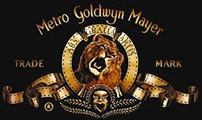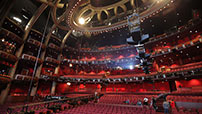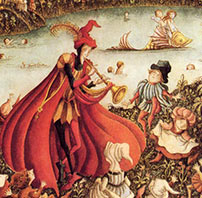| |
16:9 in English: The Oscar Deception
By EDWARD JAY EPSTEIN
The Academy Awards are central to the Hollywood industry. More precisely, they are central to the storytelling and illusionism of Hollywood. The productions that win at the Oscars, that is, are notably different from the films that are truly essential to the Hollywood economy. Today, the Hollywood economy is driven essentially by blockbusters, franchises and dubious entertainment. Oscar, on the other hand, insists on telling another and more glorified story about Hollywood – Hollywood as a producer of deep and insightful art.
Each year a global audience, second in size only to the Super Bowl, watches television’s most lucrative infomercial: the Annual Academy Awards. For some three and a half
hours, interspersed with clips from currently-available movies, Hollywood’s most publicized stars will ecstatically award the winners 13-inch-high gold-dipped statuettes known the world over as the Oscars.
The initial purpose of this gala event, which the studios created along with the Academy of Motion Picture Arts and Sciences in 1927, was, in the words of its main architect Louis B. Mayer, “to establish the industry in the public’s mind as a respectable institution.” (fig. 1-2).
But it was also designed to market and create “stars.” Mayer was cofounder of Metro-Goldwyn-Mayer, one of Hollywood’s most successful studios during its Golden Age (1930–1950), and is known as the father of Hollywood’s “star system” of marketing.
The 85th Academy Awards this February 2013 will be no different. It will have the same scripted speeches by stars, tearful acceptances, eulogies, red-carpet celebrity fashion show, and gold-dipped statuettes, and the same mission that it did when Louis B. Mayer convinced the other studio moguls to create the event in 1927: "establish the industry in the public's mind as a respectable institution." And this year, televised by ABC in dazzling high-definition color, the evening-long informational will further the long-standing myth that Hollywood is in the business of making great—and original—movies (cf. fig. 3-4).
This illusion, like all successful deceptions, requires misdirecting the audience's attention from the reality of its business, which is making supersized fantasy movies that worldwide audiences can viscerally react to, to a few brilliant low-budget aberrations often made by independent producers. The reason for this diversion is that Hollywood’s movie business is no longer about making movies. It is about creating properties—including TV programs, cartoons, videos, and games—that can serve as licensing platforms for a multitude of markets around the world. Once upon a time, it was different. For the first 20 years of the Academy Awards, the movie business was entirely about movies. Two-thirds of Americans went to a movie in an average week, and all the studios’ earnings came from the proceeds of the tickets sold at movie houses. But that was before the advent of television in the late 1940s. Once people could watch sports, game shows, and movies at home for free, most of the habitual audience disappeared. By the late 1970s, U.S. movie theaters, which had sold 4.8 billion tickets in 1948, sold only 1 billion. Hollywood, on the verge of financial ruin, had no choice but reinvent itself.
The studios simply followed their audiences home. To do this, they first repackaged the movies shown at theaters Pied Piper-style (fig. 5) by making movies that visually appealed mainly to children and teenagers and then recycled them into home products, including DVDs, TV shows, games, and toys, which, in 2005, produced more than 86 percent of their revenues.
In this business model, alas, art, literary, and social-commentary movies are marginalized, since they cannot be either turned into licensing franchises or used to lure huge opening-week audiences to theaters. And, as satisfying as these art films may be to directors, writers, actors, and producers, they do not lend themselves to sequels, prequels, or other licensable properties. They do, however, perform one function very well: acting as decoys at Hollywood's annual celebration of itself. They focus the attention of the worldwide Oscar audience on what it wants the public to believe its values.
Consider, for example, the winner that last year, The Artist (2011) (fig. 6). It won no less than five Oscars, including Best Picture. Could there be a more polar opposite to what Hollywood actually makes? The Artist is a silent movie, and Hollywood stopped making in 1927. It is filmed in Black & White, and Hollywood does not make black/white movies because it cannot license them to television, and such licencing is it principal source of profits. And it has no American stars, which facilitates their sale in Asia. In short, the Academy chose of movie that Hollywood could never make. Or, go back two years, to the competition between Kathryn Bigelow’s The Hurt Locker (2008) and James Cameron’s Avatar (2009) (fig. 7-8).
Avatar is the type of product through which Hollywood dominates both movies and television. It is a fantasy-based movie about alien life forms who need to be rescued from neo-colonialist corporate exploitation on a planet called Pandora. It has brilliant visual effects, a simple story, and a happy ending. It cost over $225 million to produce and another $150 million to publicize and distribute. I sold a record-breaking $750 million of tickets in the US, where it is shown in 3D as well as the traditional 2D format, and more than twice that amount overseas.
The Hurt Locker, on the other hand, is a reality-based film about a squad of American soldiers who defuse bombs under horrendous conditions in Iraq. By Hollywood standards, it is a very small movie, costing only $15 million to produce and another $15 million to publicize and distribute. And although critically acclaimed, it sold only $18.5 million in tickets worldwide, and lost money. Nevertheless, it not Avatar won the Oscar for Best Picture.
There are then two visions of Hollywood. The one it wants to foist of the public is the “Hurt Locker” vision of artistic, meaningful, and intellectual movies made on small-budgets by dedicated directors. That is the vision that will be displayed at the Oscar event. The other vision is the one it needs to conceal from public scrutiny is the “Avatar” vision of comic-book action-movies style movies, which like rides in an amusement park, require little dialogue or intellectual context, to absorb their impact. It is these latter movies, the ones that you will not see much of at the Oscars, that crank Hollywood’s money machine and allow it to dominate the world of filmed entertainment. |
|


Fig. 1-2: The idea behind AMPAS, according the main architect Louis B. Mayer, was “to establish the industry in the public’s mind as a respectable institution”. Mayer was one of the “founding fathers” of The Academy Awards, aside from being cofounder of MGM.


Fig. 3-4: The Academy Awards will be televised by ABC, live from the Dolby Theatre, on February 24, 2013.

Fig. 5: Pied Piper is a fictional rat-catcher who, according to legend, came to the town of Hamlin to take care of a rat infestation. Using his pipe, he managed to lure the rats into the Weser River, but he was never duly rewarded.

Fig. 6: The true artistry of The Artist was the deceptive story that it told of Hollywood – Hollywood as a producer of deep and insightful art rather than cheap entertainment.


Fig. 7-8: Katrhyn Bigelow’s low-budget war movie, The Hurt Locker,won the award for best picture in 2009, even if James Cameron’s Avatar – with its kitschy re-introduction of 3D, its blockbuster aesthetics and its franchising potential – was more typical of Hollywood as an industry and more central to the Hollywood economy. |
|